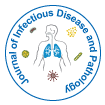Biomarkers for Treatment Response in Infectious Diseases: Precision in Practice
Received: 01-Mar-2025 / Manuscript No. jidp-25-164130 / Editor assigned: 03-Mar-2025 / PreQC No. jidp-25-164130 / Reviewed: 17-Mar-2025 / QC No. jidp-25-164130 / Revised: 23-Mar-2025 / Manuscript No. jidp-25-164130 / Published Date: 31-Mar-2025
Keywords
Infectious diseases; Treatment response; Biomarkers; Personalized medicine; Precision medicine; Therapeutic monitoring; Prognostic indicators; Host-pathogen interaction; Immune response biomarkers
Introduction
Infectious diseases remain a significant global health challenge, with timely and effective treatment being crucial to improving patient outcomes. However, the variability in host immune responses, pathogen characteristics, and therapeutic efficacy underscores the need for personalized approaches in infection management [1]. Biomarkers have emerged as powerful tools for guiding treatment decisions, offering insights into disease activity, therapeutic response, and prognosis. By enabling real-time monitoring of infection dynamics and host responses, biomarkers pave the way for precision medicine in infectious disease care [2]. This approach not only enhances treatment efficacy but also minimizes the risk of drug resistance and adverse effects. As research continues to uncover novel biomolecular indicators, integrating biomarker-based strategies into clinical practice holds promise for revolutionizing infectious disease therapy and improving public health outcomes worldwide [3].
Discussion
The use of biomarkers to monitor treatment response in infectious diseases has transformed clinical decision-making, especially in the era of precision medicine [4]. Biomarkers serve as measurable indicators of biological processes or pharmacologic responses and are instrumental in identifying patient-specific therapeutic needs, predicting outcomes, and optimizing treatment regimens. One of the major advantages of treatment response biomarkers is their ability to provide real-time insights into the host-pathogen interaction [5]. For instance, C-reactive protein (CRP) and procalcitonin are widely used in bacterial infections to monitor inflammation and assess response to antibiotics. These markers assist clinicians in determining whether to escalate, continue, or discontinue therapy—supporting antimicrobial stewardship efforts and reducing the risk of resistance [6].
In viral infections, biomarkers such as HIV viral load and Hepatitis B surface antigen levels are standard tools for evaluating the effectiveness of antiretroviral and antiviral therapies. Monitoring viral replication through such markers ensures that treatment remains on track and informs timely adjustments in therapy. Emerging immune and genomic biomarkers, including cytokine profiles, microRNAs, and gene expression signatures, are expanding the scope of precision treatment [7]. These advanced tools help differentiate between responders and non-responders to therapy and offer clues to potential complications such as immune reconstitution or cytokine storm syndromes, particularly relevant in infections like COVID-19. Despite the progress, challenges remain. Many promising biomarkers lack validation in diverse patient populations, and their integration into routine care is limited by cost, access to advanced diagnostics, and a lack of standardization [8]. Furthermore, the interpretation of biomarker data must be context-specific, considering factors such as age, comorbidities, and co-infections that may influence results.
Future directions involve the development of multi-biomarker panels and AI-driven predictive models, which can synthesize complex datasets to provide more accurate and individualized treatment guidance [9]. Collaborative efforts between clinicians, researchers, and regulatory agencies are also essential to accelerate biomarker validation and implementation. In conclusion, biomarkers hold immense potential in personalizing treatment response in infectious diseases. Their continued development and integration into clinical pathways will play a pivotal role in enhancing patient care, improving outcomes, and fostering responsible use of antimicrobials in the face of evolving global health threats [10].
Conclusion
Biomarkers have become indispensable tools in the modern management of infectious diseases, particularly in monitoring and predicting treatment response. By offering real-time, individualized data on disease progression and therapeutic efficacy, they enable more accurate and tailored interventions that align with the principles of precision medicine. From commonly used inflammatory markers to cutting-edge molecular signatures, biomarkers enhance clinical decision-making, promote antimicrobial stewardship, and ultimately improve patient outcomes. However, the full potential of biomarkers will only be realized through continued investment in research, validation across diverse populations, and integration into standardized clinical protocols. As diagnostic technologies advance and multi-omics approaches become more accessible, the future holds promise for even more sophisticated biomarker-guided strategies. Embracing these innovations will be key to overcoming the evolving challenges posed by infectious diseases and strengthening global health systems.
References
- Hodgkin K (1985) Towards Earlier Diagnosis. A Guide to Primary Care. Churchill Livingstone.
- Last RJ (2001) A Dictionary of Epidemiology. Oxford: International Epidemiological Association.
- Kroenke K (1997) Symptoms and science: the frontiers of primary care research. J Gen Intern Med 12: 509–510.
- Kroenke K (2001) Studying symptoms: sampling and measurement issues. Ann Intern Med 134: 844–853.
- Komaroff AL (1990) ‘Minor’ illness symptoms: the magnitude of their burden and of our ignorance. Arch Intern Med 150: 1586–1587.
- Sackett DL, Haynes BR, Tugwell P, Guyatt GH (1991) Clinical Epidemiology: a Basic Science for Clinical Medicine. London: Lippincott, Williams and Wilkins.
- Mullan F (1984) Community-oriented primary care: epidemiology's role in the future of primary care. Public Health Rep 99: 442–445.
- Mullan F, Nutting PA (1986) Primary care epidemiology: new uses of old tools. Fam Med 18: 221–225.
- Abramson JH (1984) Application of epidemiology in community oriented primary care. Public Health Rep 99: 437–441.
- Hart JT (1974) The marriage of primary care and epidemiology: the Milroy lecture, 1974. J R Coll Physicians Lond 8: 299–314.
Google Scholar, Crossref, Indexed at
Google Scholar, Crossref, Indexed at
Citation: Eying Z (2025) Biomarkers for Treatment Response in Infectious Diseases: Precision in Practice. J Infect Pathol, 8: 286.
Copyright: © 2025 Eying Z. This is an open-access article distributed under the terms of the Creative Commons Attribution License, which permits unrestricted use, distribution, and reproduction in any medium, provided the original author and source are credited
Select your language of interest to view the total content in your interested language
Share This Article
Recommended Journals
Open Access Journals
Article Usage
- Total views: 611
- [From(publication date): 0-0 - Dec 20, 2025]
- Breakdown by view type
- HTML page views: 484
- PDF downloads: 127
